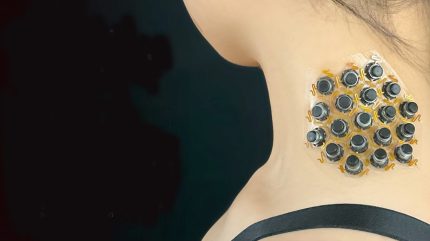
A team of engineers led by Northwestern University in the US has developed a new wearable haptic patch that transmits different complex sensations to the skin.
This thin and flexible device has been designed to adhere to the skin gently and provides realistic and immersive experiences that extend beyond gaming and virtual reality (VR) into potential healthcare applications.
It could assist visually impaired individuals in sensing their environment or provide feedback for prosthetic limb users.
A study, recently published in Nature, showcases the latest advancement in wearable technology from Northwestern University Materials Science and Engineering, Biomedical Engineering, and Neurological Surgery Louis A Simpson and Kimberly Querrey professor John Rogers.
It builds on the concept of “epidermal VR”, introduced in 2019, which communicates touch through wirelessly controlled vibrating actuators.
Rogers said: “Our new miniaturised actuators for the skin are far more capable than the simple ‘buzzers’ that we used as demonstration vehicles in our original 2019 paper.
How well do you really know your competitors?
Access the most comprehensive Company Profiles on the market, powered by GlobalData. Save hours of research. Gain competitive edge.

Thank you!
Your download email will arrive shortly
Not ready to buy yet? Download a free sample
We are confident about the unique quality of our Company Profiles. However, we want you to make the most beneficial decision for your business, so we offer a free sample that you can download by submitting the below form
By GlobalData“Specifically, these tiny devices can deliver controlled forces across a range of frequencies, providing constant force without continuous application of power. An additional version allows the same actuators to provide a gentle twisting motion at the surface of the skin to complement the ability to deliver vertical force, adding realism to the sensations.”
Comprising a hexagonal array of 19 small magnetic actuators encased in silicone mesh, the device can simulate sensations such as pressure, vibration, and twisting.
It uses Bluetooth technology to translate environmental data into tactile feedback, effectively substituting vision with touch.
The device’s energy efficiency is due to its “bistable” design, which allows it to maintain two stable positions without constant energy use.
Energy is stored in both the skin and the device’s structure when actuators press down and released when they push up.
Rogers co-led the work with Yonggang Huang of Northwestern University, Hanqing Jiang of Westlake University in China; and Zhaoqian Xie of Dalian University of Technology in China who helped build the small modifying structures needed to enable twisting motions.
Researchers tested the device’s effectiveness by blindfolding healthy participants to assess their ability to navigate obstacles, adjust foot placement, and maintain balance.
In one test, as subjects neared an object, the device intensified feedback from light pressure in its upper right corner towards the centre.
With minimal training, subjects could modify their behaviour in real time using the feedback.



